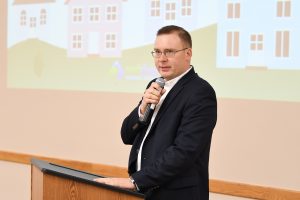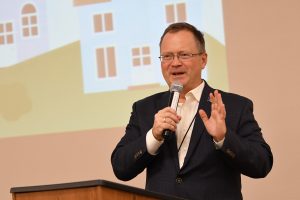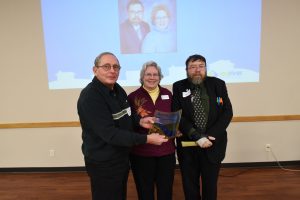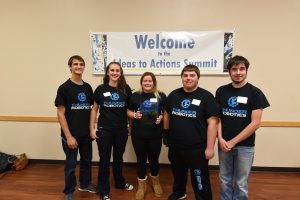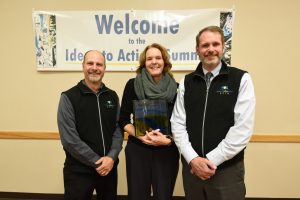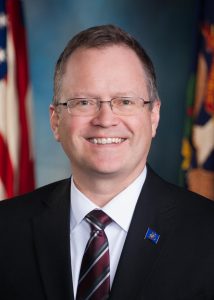December 11, 2017
TOURISM GROWTH EFFORT UNDERWAY IN NORTHEAST NORTH DAKOTA
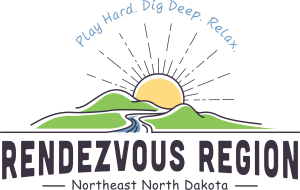 For the past year, a group of approximately 15 regional leaders have been meeting to relaunch the Rendezvous Region Tourism Council which was first initiated 25 years ago. Initially started as a partnership between the cities of Langdon, Walhalla, Cavalier and Pembina, the group has grown to include Cavalier, Pembina, and Walsh Counties. At their meeting last Thursday at Frost Fire near Walhalla, the council adopted its new logo and is in the process of developing a marketing campaign to spread the awareness of the many recreational and cultural amenities in northeast North Dakota.
The council’s mission is to build a cohesive tourism brand through education, marketing and amenity enhancement. The new logo emulates an attractive destination and was designed to reflect the varied landscape of prairie, rolling hills, and the Pembina Gorge. The logo tagline references a variety of outdoor recreation amenities, rich cultural and prehistoric history, and the serene nature.
The group is currently developing a membership model to build annual revenue to invest in marketing of the area. In 2017, the council had a six-page regional feature in the Fargo-based High Plains Reader, developed a Facebook page, and has secured a full-page ad in the 2018 ND Travel Guide which reaches more than 300,000 people. The Cavalier County Lodging Tax Committee committed $1,250 towards the 2018 ND Travel Guide based on participation from Walsh and Pembina Counties. The Pembina County JDA became a founding member of the revived tourism council with its $10,000 contribution at their meeting on November 8, 2017. Tourism is a priority economic development strategy.
On Prairie Software, a Walhalla based software development company, is also launching the “Find ND” smart phone application that people can use to plan their trip to the Rendezvous Region and learn more about the area. The group is also exploring additional uses of technology to provide education availability at all times. According to Nathan Smith, On Prairie Software President, “Technology gives visitors an immediate personalized guide to the region and allows us to be proactive in showing what the region has to offer.”
Tourism is the state’s third largest industry, behind energy and agriculture. According to a North Dakota State University study, tourism generated more than $25 million in 2015 within the Rendezvous Region. In 2015, jobs in arts, entertainment, recreation, accommodation and food service comprised 509 jobs in this region.
“Tourism development is really about destination development and being high quality of place that draws both visitors and enhances the quality of life for residents,” said Dawn Keeley, a member of the group. “Our heightened emphasis on destination development is aimed to assist in stopping a 70-year trend of population decline and filling the jobs openings that we have.”
A recent Pew Research Foundation study revealed 51% of people prefer living in small towns and rural areas with the primary reason being safety and security, affordable housing, and relaxed life style.
The peak population level in the Rendezvous Region was in 1940 with 50,341 people with the 2016 population estimated at 21,800. Since 1990, these three counties have lost 25% of their population or 7,342 people. This population loss equates to the current populations of the cities of Grafton, Cavalier, and Langdon combined.
There are more than 1.2 million people within a two-hour drive of the Rendezvous Region. Northeast North Dakota is the only part of the state with that significant population density to draw from for visitors which can equate to more business revenue for area hotels, campgrounds, restaurants and main street businesses.
The region has an array of existing niche businesses within the region that provide interesting experiential shopping, activities such as painting, arts and crafts, design, as well as a variety of coffeeshops, bakeries, artisans, restaurants and recreation amenities. There are numerous available buildings throughout the Rendezvous Region that could be filled with additional niche businesses to create more vibrancy on main streets.
“Promoting the Rendezvous Region as a whole has a great impact on all of the communities within it. Collectively, we have so much more to offer when we work together instead of standing alone,” said Rachel Morrison, Executive Director, Cavalier Area Chamber of Commerce and Tourism.
Barb Mehlhoff, Langdon Chamber of Commerce, shared, “Langdon is proud to be the Western Gateway to the Rendezvous Region. We are looking forward to the positive effects that marketing of the Rendezvous Region will bring to Langdon and all the communities in the three counties. Marketing of this little treasure of northeast North Dakota is important for our communities to continue to grow and prosper by increasing tourism in the future.”
Current members of the tourism council include: Barb Mehlhoff, Langdon Chamber of Commerce; Rachel Morrison, Cavalier Area Chamber of Commerce & Tourism; Julie Campbell, Walsh County JDA; Kathy Stremick, Pembina County JDA; Mike Duerre, ND Parks and Recreation; Bill Dahl, Grafton Parks and Recreation; Marlys Boll, Ox Cart Trails Historical Society, Drayton; Nathan Smith, On Prairie Software, Walhalla; Zelda Hartje, Pembina County Historical Museum; Kristi Wilfahrt, Pembina Gorge Foundation; Kari Helgoe, NDSU Extension, Pembina County; Dennis Sevigny, Grafton Chamber of Commerce; Cheryl Osowski, RRRC/Walsh/Pembina Historic Preservation Commissions; Maggie Suda, RRRC/Pembina County JDA; and Dawn Keeley, RRRC/Pembina County JDA.
More information can be found on the council’s Facebook page: https://www.facebook.com/rendezvousregion/
For the past year, a group of approximately 15 regional leaders have been meeting to relaunch the Rendezvous Region Tourism Council which was first initiated 25 years ago. Initially started as a partnership between the cities of Langdon, Walhalla, Cavalier and Pembina, the group has grown to include Cavalier, Pembina, and Walsh Counties. At their meeting last Thursday at Frost Fire near Walhalla, the council adopted its new logo and is in the process of developing a marketing campaign to spread the awareness of the many recreational and cultural amenities in northeast North Dakota.
The council’s mission is to build a cohesive tourism brand through education, marketing and amenity enhancement. The new logo emulates an attractive destination and was designed to reflect the varied landscape of prairie, rolling hills, and the Pembina Gorge. The logo tagline references a variety of outdoor recreation amenities, rich cultural and prehistoric history, and the serene nature.
The group is currently developing a membership model to build annual revenue to invest in marketing of the area. In 2017, the council had a six-page regional feature in the Fargo-based High Plains Reader, developed a Facebook page, and has secured a full-page ad in the 2018 ND Travel Guide which reaches more than 300,000 people. The Cavalier County Lodging Tax Committee committed $1,250 towards the 2018 ND Travel Guide based on participation from Walsh and Pembina Counties. The Pembina County JDA became a founding member of the revived tourism council with its $10,000 contribution at their meeting on November 8, 2017. Tourism is a priority economic development strategy.
On Prairie Software, a Walhalla based software development company, is also launching the “Find ND” smart phone application that people can use to plan their trip to the Rendezvous Region and learn more about the area. The group is also exploring additional uses of technology to provide education availability at all times. According to Nathan Smith, On Prairie Software President, “Technology gives visitors an immediate personalized guide to the region and allows us to be proactive in showing what the region has to offer.”
Tourism is the state’s third largest industry, behind energy and agriculture. According to a North Dakota State University study, tourism generated more than $25 million in 2015 within the Rendezvous Region. In 2015, jobs in arts, entertainment, recreation, accommodation and food service comprised 509 jobs in this region.
“Tourism development is really about destination development and being high quality of place that draws both visitors and enhances the quality of life for residents,” said Dawn Keeley, a member of the group. “Our heightened emphasis on destination development is aimed to assist in stopping a 70-year trend of population decline and filling the jobs openings that we have.”
A recent Pew Research Foundation study revealed 51% of people prefer living in small towns and rural areas with the primary reason being safety and security, affordable housing, and relaxed life style.
The peak population level in the Rendezvous Region was in 1940 with 50,341 people with the 2016 population estimated at 21,800. Since 1990, these three counties have lost 25% of their population or 7,342 people. This population loss equates to the current populations of the cities of Grafton, Cavalier, and Langdon combined.
There are more than 1.2 million people within a two-hour drive of the Rendezvous Region. Northeast North Dakota is the only part of the state with that significant population density to draw from for visitors which can equate to more business revenue for area hotels, campgrounds, restaurants and main street businesses.
The region has an array of existing niche businesses within the region that provide interesting experiential shopping, activities such as painting, arts and crafts, design, as well as a variety of coffeeshops, bakeries, artisans, restaurants and recreation amenities. There are numerous available buildings throughout the Rendezvous Region that could be filled with additional niche businesses to create more vibrancy on main streets.
“Promoting the Rendezvous Region as a whole has a great impact on all of the communities within it. Collectively, we have so much more to offer when we work together instead of standing alone,” said Rachel Morrison, Executive Director, Cavalier Area Chamber of Commerce and Tourism.
Barb Mehlhoff, Langdon Chamber of Commerce, shared, “Langdon is proud to be the Western Gateway to the Rendezvous Region. We are looking forward to the positive effects that marketing of the Rendezvous Region will bring to Langdon and all the communities in the three counties. Marketing of this little treasure of northeast North Dakota is important for our communities to continue to grow and prosper by increasing tourism in the future.”
Current members of the tourism council include: Barb Mehlhoff, Langdon Chamber of Commerce; Rachel Morrison, Cavalier Area Chamber of Commerce & Tourism; Julie Campbell, Walsh County JDA; Kathy Stremick, Pembina County JDA; Mike Duerre, ND Parks and Recreation; Bill Dahl, Grafton Parks and Recreation; Marlys Boll, Ox Cart Trails Historical Society, Drayton; Nathan Smith, On Prairie Software, Walhalla; Zelda Hartje, Pembina County Historical Museum; Kristi Wilfahrt, Pembina Gorge Foundation; Kari Helgoe, NDSU Extension, Pembina County; Dennis Sevigny, Grafton Chamber of Commerce; Cheryl Osowski, RRRC/Walsh/Pembina Historic Preservation Commissions; Maggie Suda, RRRC/Pembina County JDA; and Dawn Keeley, RRRC/Pembina County JDA.
More information can be found on the council’s Facebook page: https://www.facebook.com/rendezvousregion/
December 6, 2017
Bids solicited for Nelson County Health System elevator project
Nelson County, on behalf of Nelson County Health System, has been awarded a Community Development Block Grant (CDBG) for an elevator project at the critical access hospital located in McVille, ND. Bids are currently being solicited for contractors to complete the work. Bids are due no later than 4:00 PM on Thursday, December 28, 2017. A complete bid package is available here: BID PACKAGE - ALL DOCUMENTS. (Please note: The file is large and make take a few minutes to download.) Anyone with questions on bid package documents can contact Stacie Sevigny at 701-352-3550 or Stacie@redriverrc.com. Please be advised there are two bid worksheets to be completed. For on-site inspection or questions relating to specific bid items, please contact Steve Forde at Nelson County Health System at 701-322-4328, ext. 227.
November 6, 2017
Regional Council Honors Four Award Winners
Nominees and recipients were recognized at the Third Annual Ideas to Actions Summit on November 2
The Red River Regional Council (RRRC) honored 13 nominees and provided four awards at its 3rd annual Ideas to Actions Summit held November 2 in the Minto Community Center. Attended by more than 130 people, the event was designed to celebrate people striving to build their communities, provide an opportunity for leaders in the region to collaborate and discuss issues, and celebrating the big ideas and hardworking, creative people living in the small towns of northeastern North Dakota. “We are grateful for the Minto Community Center – it was a perfect venue to cultivate regional synergies and a classic example of the embodiment of our theme for this year’s Summit – Small Towns. Big Ideas,” Said Dawn Keeley, RRRC Executive Director. A caucus of regional city and county leaders was held prior to the Summit. The caucus featured speakers including Lt. Governor Brent Sanford, Mark Schill of Praxis Strategy Group, and Blake Crosby, Executive Director of the ND League of Cities. The keynote event, in addition to the awards program, included presentations by Benjamin Winchester, Senior Research Fellow for the University of Minnesota Extension, Center for Community Vitality, and Christopher Ingraham, reporter for The Washington Post, as well as presentation of the awards. Winchester, in his presentation entitled “Changing the Rural Narrative” discussed how rural America is changing, not dying. As agriculture became mechanized, labor and jobs changed. “Roll with the punches and figure out what we are doing next,” said Winchester. “Newcomers choose the rural lifestyle for the following top three reasons: a simpler pace of life, safety and security, and low housing cost. Jobs were not in the top ten driving factors for relocation and therefore, economic development efforts need to change to a ‘resident recruitment’ strategy. With 46% of North Dakota residents moving every five years, there are opportunities for recruitment.” According to Pew Research, 51% of people would like to live in a small town or rural area. Ingraham shared his professional and personal story after writing in the Washington Post that Red Lake County, MN, was the worst place to live in the United States in 2015. Red Lake County promptly invited Ingraham to visit and his editor was “suspiciously enthusiastic” of the idea of sending him to MN. His first impression, upon arrival, forced him to pull over during his drive four or five times to take in the landscape. “The land was flat and the sky was huge – so peaceful,” said Ingraham. “I was struck by the sense of community pride and that everyone here was trying to make it a better place.” Upon his mom’s suggestion to consider moving to MN, he and his wife considered and concluded it would be economically irresponsible not to move. He, his wife, three sons, two rabbits and one beagle now live in Red Lake Falls, MN. After relocating in May 2016, Ingraham heard from people all over the world – some who had always wanted to make a similar move but had regretted not doing so. “People already want to live here, you don’t need to sell them – show them it’s possible,” said Ingraham. Great Ideas, Projects and Leaders Recognized The RRRC awards program was designed to recognize and reward the leadership and commitment demonstrated in communities across the Red River region. A total of 13 nominations from across the four-county region were received for the three categories. Winners were selected by the RRRC Board of Directors. The three categories included: Catalyst Award. This award recognizes an individual who acts as a kick starter for an idea or project. The winner of the Catalyst Award was Dr. Doug and Dr. Laura Munski. The Munskis have given a more than 30-year commitment to provide great STEM learning opportunities for students and STEM teacher resources in northeast North Dakota and across the state. Determination Award: This award recognizes successful projects that create a significant impact on a community. Winner of the Determination Award was Thunder Robotics Team 876, Northwood/Hatton Schools. This team includes students from five North Dakota counties and has made it to the FIRST Robotics World Championship each of the last three years. North Star Award: This award recognizes ideas to illuminate opportunities or create a guiding light for progress within a community.
North Star Addition/Park River Development Corporation - Steve Rehovsky, Harold Myrdal, Nancy Thompson, Darrel Larson, and Gary Paulson
- AE2S
- Bank of North Dakota
- City of Grafton
- City of Grand Forks
- Construction Engineers
- Grand Forks Region EDC
- Kadrmas, Lee & Jackson
- Nelson County JDA
- Park River EDC
- Pembina County JDA
- Red River Regional Council
- Walsh County JDA
October 17, 2017
Small Towns, Big Ideas: Third Annual Ideas to Actions Summit to focus on small towns and committed people
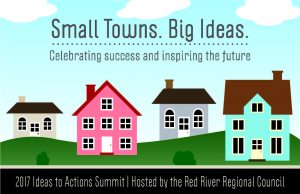 Agenda
4:00 Mayors Caucus
Agenda
4:00 Mayors Caucus
- Welcome, Mayor Lane Kelley (Minto)
- Main Street Initiative and Beyond, Lt. Governor Brent Sanford
- State of the Region, Mark Schill, Praxis Strategy Group
- Building Your City's Economic Ecosystem, Blake Crosby, ND League of Cities
- Welcome, Mayor Lane Kelley (Minto)
- Opening Comments, Dawn Keeley, Red River Regional Council
- Main Street Initiative Highlights, Lt. Governor Brent Sanford
- Rewriting the Rural Narrative, Ben Winchester, U of M Extension
- Community Builder Awards Ceremony
- Living the Good Life in America's Worst Place to Live, Chris Ingraham, Washington Post
Role of LSTC evolves in 113-year history
Reprinted with permission of The Walsh County Record. First appeared in the September 27, 2017 edition. First of a four part feature series. by Cheryl Osowski Mission critical is defined as any factor of an existing system that is essential to its operation. Through its 113-year history, Grafton’s current Life Skills and Transition Center (LSTC) has operated with a mission critical to the continuum of services North Dakota has provided for people with intellectual and developmental disabilities. The facility provided a safe haven for a variety of people with no other place to go. When society’s knowledge and understanding of the needs of the people served evolved and behavioral treatment and training expanded, the Center’s philosophy of care changed. However, the resources provided did not keep up. Too few staff were charged with the care of too many people, some of whom had no diagnosis of intellectual or developmental delay. Services and alternative housing for these individuals were not available in the numbers required and family members were uninterested or unable to provide. In many cases, the Center was the recommended placement for their loved one. Over time, leaders of the state and at the Center shifted their philosophy of care. From protectionism and medically driven care, to limited education and training, and finally to a comprehensive view of care and education that included the expansion of services statewide that diminished the need for the Center’s living space. The most dramatic precipitator of change was the implementation order by U.S. district judge Bruce Van Sickle, issued in the 1984 lawsuit Association for Retarded Citizens of North Dakota v. Olson. Numbers tell the story of these philosophical and mandated shifts in care over the life of the Center. Statistics taken from the comprehensive book on the history of the Center written by Brent Askvig, Ph.D., professor of special education at Minot State University, tell the story of change. According the Askvig book, six people were admitted on May 2, 1904. By the first of November that year, 75 people resided at what then was named the Institution for the Feeble Minded. Grafton was chosen as the location for this facility in 1901, which was suggested by Walsh County Senator J. C. Cashel. Training programs were begun in 1904 and focused on training so the people could be happy, comfortable, and so that life there could be useful. The early years also were plagued by infectious diseases which caused over 78 deaths in the first six years the facility was open. Efforts to survey and consolidate people with disabilities were initiated in 1911, resulting in a census that predicted there to be 1,800 more people who would need institutionalization. The period between 1910 and 1930 noted for “paternalistic and protectionist approach” as Askvig notes in his book. By 1940, the population of the institution was up to 970 people. Although World War II severely limited expansion, the Refectory was added in 1949 and the hospital building in 1950. During this decade, the population rose to 1,091 people. During what Askvig terms the “Modernization” period of the 1950s, the population increased to 1,381 residents. During this period psychologists were added to the spectrum of professional care provided, as were educational efforts and a recreation program. The institution’s name had also changed to the Grafton State School. Spurred by greater public advocacy on behalf of people with disabilities, the decade of the 1960s represented the beginning of significant changes in the way services were viewed by the public and by policymakers. It was also the decade when a second institution opened to “provide custodial care to senile, geriatric patients” – San Haven, a facility which formerly housed North Dakota’s sanitorium for tuberculosis patients. The population at Grafton rose to nearly 1,500 people, while 150 people resided at San Haven. Between 1970 and 1980, the population at Grafton decreased from 1,351 to 988. San Haven’s population increased slightly from 225 to 248. The overall decline was partly due to the establishment of some community programs and a tightening of admittance procedures. Another lawsuit, a precursor to the 1980s suit, was filed by the ARC alleging denial of public education for students. Increasing public advocacy and changing state and federal law were having an impact. A 1999 U.S. Supreme Court decision, Olmstead vs. L.C., ruled that the unjustified segregation of people with disabilities is a form of unlawful discrimination under the Americans with Disabilities Act (ADA), asserting more pressure to deinstitutionalize. During the period from the 1980s to today, the change has been drastic. The facility’s name changed twice – the Grafton State School became the Grafton Developmental Center in 1989 and is now named the Life Skills and Transition Center. Residential buildings were remodeled and constructed to mimic group homes. While the number of people living at the facility dropped precipitously, staffing levels increased. In 1981, there were 674 staff positions, but that number increased to 1,072 in 1987. Today, there are 64 people served at the Center, with the number of full-time positions at 339.94. The current mission of the LSTC is to support people to be viable members of their communities by providing specialized services when their needs exceed community resources. In addition to supervising people living in community homes located adjacent to the original footprint of the institution, staff of the LSTC supervise a program of staff located statewide known as the Clinical Assistance, Resources and Evaluation Service (CARES). CARES is a team of specialists including clinical and direct support staff who provide a wide range of consultation services, including in-home and on-site supports meant to prevent admission or readmission to the LSTC and to assist in transitioning people from the LSTC. CARES logs between 150 and 225 service events per year. A CARES Clinic assures that people have access to physical, occupational, and speech therapy services and consults, in addition to providing adaptive equipment, dental and medical services to people under the care of other providers. Behavioral health services are also provided by LSTC staff on a fee-for-service basis statewide. Since 1989, the Council on Quality and Leadership (CQL) – a national organization dedicated to defining, measuring and improving the personal and community quality of life for people with intellectual and developmental disabilities – has accredited the LSTC. Its current accreditation extends to 2020. The LSTC is the only former institution in the U.S. to achieve this accreditation under the new standards. Yet, while no longer in the business of providing institutionalized care, the Center is now facing the headwinds of a movement to discard any remnants of the prior institution in favor of services provided by a network of providers in other locations across the state. A resolution advocating a study of the closure of the LSTC failed in the ND Senate in 2017. However, an interim committee study of behavioral services in the state was approved. The study includes a provision that requires “an evaluation of the funding, mission, and caseload at the Life Skills and Transition Center, including the center’s transition plan and number of clients eligible for community placement.” In addition to these legislative actions, the ND Department of Human Services (NDDHS) has moved a position from the Center to Bismarck. The position was retitled to Transition and Diversion Coordinator, with the responsibility to monitor vacancies across the provider network in ND and the readiness of people living at the Center to move into those vacancies. The author of the definitive history of the Center at Grafton, Dr. Brent Askvig, continues to give 3-4 lectures per year to students at Minot State University on the contents of the book. He states that his students gasp in horror when hearing how people were treated through the years at the institution. He is glad to say that we are doing pretty good right now. “I hope we continue to move forward,” Askvig said. “To say that we have solved all the problems at any given time would be inappropriate.” He is amazed at what is happening with technology and what it can offer in the future. “I get excited when I think about that, he said.” When asked about the nomenclature of the services discipline and the term institution, Askvig says he would refer to any large facility an institution, including those larger private providers in the state that supervise large congregated housing and training facilities. “The term is applicable to more than just the Grafton facility,” he said. In written testimony provided to the interim committee at their first meeting August 1, 2017, Sue Foerster, Superintendent at the LSTC, indicated that ongoing work is needed to transform the LSTC. A transition task force established in 2005 will continue to study the reasons people are admitted to, remain at, and transition home from the LSTC. She also wants to fully define the safety net role of the LSTC in a way that all stakeholders, NDDHS and community partners agree upon. She also testified that the work of the LSTC Professional Services Institute on Developmental Disabilities to support private provider capacity to support people with developmental disabilities and behavioral health challenges should be continued. The vacated buildings on campus create a separate and challenging dilemma to the future of the Center. The emptying of the oldest dormitory style buildings on the campus grounds drove a concerted effort by local developers and legislators to redevelop some building on the campus for housing. Dawn Keeley, executive director of the Red River Regional Council (RRRC), was part of the effort in the 1990s to convert two of the oldest buildings on the grounds, North A and North B, into rental housing units. Keeley noted that in 1993 a regional steering committee was formed to find alternative uses for the campus. With a $100,000 grant from ND Department of Economic Development and Finance to the Walsh County Job Development Authority, the work began. Several steps were taken to free up the process of transferring ownership of state building assets to new owners. Finance packages were worked out, market research was completed, and developers were sought. Construction was underway on the renovations of North A and North B in 1998 and 1999. Other buildings such as the newer administration building and hospital building were utilized by other service providers, including the ND Motor Vehicle branch, the Veterans Administration, Northeast Human Services, and day care providers. The auditorium utilized for recreational programming for clients was opened to the entire Grafton community as a community fitness center. Homes built for medical staff and the superintendent on the grounds were converted into independent supervised living arrangements for people still served by the staff at the Center. Today a collaborative effort including the City of Grafton, the Walsh County Job Development Authority, the Praxis Strategy Group of Grand Forks and the RRRC is underway, working on redevelopment efforts for the remaining vacated spaces. The agencies are also supporting an ongoing role for the LSTC in North Dakota’s core safety net and professional resource for the people who need the quality of care provided. “The development challenge is two-fold today – retention and redevelopment,” said Keeley. “This threat of closure brings added political challenges that we did not have in the 1990s.” In the 1990s, the redevelopment efforts had bipartisan support at the highest levels with Sen. Harvey Tallackson as the chair of the redevelopment committee while at the same time serving as the Chair of the Senate Appropriations Committee and Lt. Governor Rosemarie Myrdal also serving on the redevelopment committee. US Senator Byron Dorgan worked to develop an outreach clinic for the Veterans Administration Hospital in Fargo as well as retirement and skilled nursing beds. Sen. Tallackson recalls the work it took to find leaders who believed in the redevelopment efforts. “There were many people who just wanted to tear them down,” Tallackson said. His best advice for the current redevelopment task force is to never give up. “They should use all the pressure they can muster to get support for the foundational work of feasibility studies from the leaders at the Bank of North Dakota and the Department of Commerce,” said Tallackson. “It’s not an easy pull to get a lot of this stuff done.” Keeley’s recollection of the efforts match Tallackson’s. “I recall arranging countless tours, meetings, and trips to Bismarck while exploring many options for redevelopment including a veterans nursing home, housing, veterans’ clinic and more over a more than five-year period,” Keeley said. “A project of this magnitude requires steadfast staffing over a long term to develop the networking and partnerships necessary to result in a high-quality project.” According to Keeley, the RRRC provided approximately five years of staff time into the project, which resulted in 49 units of rental housing in what is known today as Villa DeRemer and Hancock Place. Next up in the LSTC series will be a review of the concerns of the legislators involved in the interim study, advocacy groups, and community providers. Current best practices in other states will be noted. The issue of cost of care will be reviewed. Redevelopment ideas will be outlined. Part 2: Who are the players and what are their concerns? Part 3: What do those currently receiving and providing services want and need? Part 4: What happens now?September 12, 2017
Geocaching Tour Planned for Pembina County
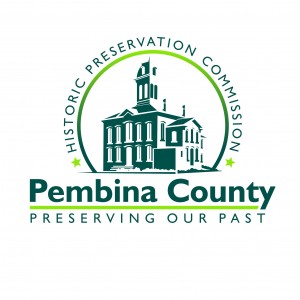 A self-driving tour of historic geocaches in Pembina County has been planned for Sunday, September 24 at 2:00 pm. The Pembina County Historic Preservation Commission is hosting the tour, which will begin with a presentation about the hobby of geocaching at the Heritage Center at Icelandic State Park west of Cavalier, ND.
Following the presentation, participants will proceed to the grounds of the Pembina County Museum to search for geocaches placed there. The group will split, with some going to geocaches in the Edinburg/Mountain area and some going to the LeRoy/Cavalier area. Transportation will be provided. Upon completion of the driving tour, refreshments will be served at the Heritage Center. This event is free and open to the public.
The Pembina County Historic Preservation Commission (PCHPC) is governed by a board appointed by the Pembina County Commission and administered by the Red River Regional Council. The PCHPC, which is the subject of this press release, has been financed in part with Federal funds from the National Park Service, a division of the United States Department of Interior, and administered by the State Historical Society of North Dakota. The contents and opinions, however, do not necessarily reflect the views or policies of the United States Department of Interior or the State Historical Society of North Dakota.
This program receives Federal funds from the National Park Service. Regulations of the U. S. Department of the Interior strictly prohibit unlawful discrimination in departmental Federally Assisted Programs on the basis of race, color, national origin, age or handicap. Any person who believes she or he has been discriminated against in any program, activity, or facility operated by a recipient of Federal assistance should write to: Director, Equal Opportunity Program, National Park Service, Department of Interior, 1849 C Street, NW, Mail Stop 2652, Washington, DC 20240.
A self-driving tour of historic geocaches in Pembina County has been planned for Sunday, September 24 at 2:00 pm. The Pembina County Historic Preservation Commission is hosting the tour, which will begin with a presentation about the hobby of geocaching at the Heritage Center at Icelandic State Park west of Cavalier, ND.
Following the presentation, participants will proceed to the grounds of the Pembina County Museum to search for geocaches placed there. The group will split, with some going to geocaches in the Edinburg/Mountain area and some going to the LeRoy/Cavalier area. Transportation will be provided. Upon completion of the driving tour, refreshments will be served at the Heritage Center. This event is free and open to the public.
The Pembina County Historic Preservation Commission (PCHPC) is governed by a board appointed by the Pembina County Commission and administered by the Red River Regional Council. The PCHPC, which is the subject of this press release, has been financed in part with Federal funds from the National Park Service, a division of the United States Department of Interior, and administered by the State Historical Society of North Dakota. The contents and opinions, however, do not necessarily reflect the views or policies of the United States Department of Interior or the State Historical Society of North Dakota.
This program receives Federal funds from the National Park Service. Regulations of the U. S. Department of the Interior strictly prohibit unlawful discrimination in departmental Federally Assisted Programs on the basis of race, color, national origin, age or handicap. Any person who believes she or he has been discriminated against in any program, activity, or facility operated by a recipient of Federal assistance should write to: Director, Equal Opportunity Program, National Park Service, Department of Interior, 1849 C Street, NW, Mail Stop 2652, Washington, DC 20240.
August 3, 2017
Seeking Nominations to Recognize Community Improvements
The impactful people, projects and ideas that make this region strong will again be celebrated at the third annual Ideas to Actions Summit, an event hosted by the Red River Regional Council (RRRC). The event is set for November 2, 2017 at the Minto Community Center. “We are excited to continue with the Ideas to Actions Summit take a bit of time to recognize people, ideas and projects moving communities forward throughout the region,” said Dawn Keeley, Executive Director of the RRRC. The RRRC is seeking nominations for the 2017 North Star, Catalyst and Determination Awards. The North Star Award will go to an idea that illuminates opportunities or creates a guiding light for progress within a community; the Catalyst Award will recognize an individual who acts as a kickstarter for an idea or a project; and the Determination Award will recognize a successful project that created a significant impact on a community. The purpose of the Ideas to Actions Summit is to create excitement about the potential of the region’s communities, and to recognize the excellent work of the region’s leaders and communities. The agenda includes a networking social, the keynote presentations which will include speakers addressing the topic of marketing our small towns and changing the rural narrative in northeast North Dakota, and the awards presentation. All events will be held at the Grafton Public School’s Performing Arts Center and are free and open to the public. More information about the award criteria and how to complete a nomination form can be accessed several ways - at the RRRC’s website at www.redriverrc.com; the RRRC’s Facebook page; by calling the RRRC office at 701.352.3550 to request a form be mailed to you; or by emailing cheryl@redriverrc.com . The deadline for nominations is September 22, 2017. The awards will be presented at the Ideas to Actions Summit in November. The RRRC is one of eight regional planning councils in North Dakota established in 1973 to enhance the ability of local governments to jointly plan, address issues, and seize opportunities that transcend individual boundaries. The RRRC serves Region IV which includes Grand Forks, Nelson, Pembina, and Walsh Counties. More information can be found at www.redriverrc.com. Ideas to Actions Summit Awards nomination form 2017 - FILLABLE WORD FINAL Ideas to Actions Summit Awards nomination form 2017 - FILLABLE FINAL
July 26, 2017
Seeking business applications for gap financing
For profit businesses with a need for additional financing to complete a capital project, invest in property or equipment, or to shore up their working capital should contact the Red River Regional Council (RRRC). The RRRC, as part of the economic and business development services they provide in Grand Forks, Nelson, Pembina and Walsh counties in North Dakota, operates two revolving loan funds, the Progress Fund and the Revolving Loan Fund (RLF), both of which have money available to loan. Loans can be requested in a range from $10,000 to $100,000 dollars. The funds provide what is referred to as “gap” financing to businesses that have purchases or projects in the works that have received some monetary commitments from primary lenders, but need additional funds to round out the total amount of funding required. According to Dawn Keeley, Executive Director of the RRRC, both funds have been essential to economic and business development in the region. “Since the inception of the funds, we have written 58 loans to businesses that have created 334 jobs in the region,” she said. “Overall, the loan programs have provided over $4.3 million in loans, with more than an additional $59.7 million leveraged from private and other public funds. We encourage any business looking for additional funding for a project or purchase to contact us immediately.” Businesses interested in a loan from this fund are urged to contact Maggie Suda, economic developer at the RRRC 701-352-3550 or maggie@redriverrc.com. Businesses will need to complete an application. All loans are subject to the approval of the RRRC Board of Directors.
June 19, 2017
2016 Annual Reports
The Red River Regional Council (RRRC) released their 2016 annual report in conjunction with the Nelson County Job Development Authority (NCJDA) and Pembina County Job Development Authority (PCJDA) 2016 annual reports. Both the NCJDA and PCJDA contract for professional services with the RRRC. Red River Regional Council 2016 Annual Report Nelson County JDA 2016 Annual Report Pembina County JDA 2016 Annual Report
April 28, 2017
Walsh and Pembina Counties Seeking Applications for Funds for Community Betterment Projects
Walsh and Pembina counties are currently seeking cities interested in funding assistance for community betterment projects. Both Pembina and Walsh counties are accepting applications for projects as part of their Self-Help Programs. There are many ways communities can use these county funds for betterment projects. Examples of projects cities used the funds toward last year include: maintenance and mowing at a city park; baseball diamond repairs; sidewalk and street repairs; Senior Center programs; and City Hall building repair. The main objective is to promote development within communities of Pembina and Walsh counties. The Red River Regional Council manages the program on behalf of the counties. There are four program criteria:
- Requests cannot exceed one-half of the total project cost, nor can the request exceed $1,500.
- The county funds must be matched 1:1. Funds will be released on a reimbursement basis with supporting documentation.
- A copy of a resolution or minutes of the meeting when the applicant authorized the project must be included with the application. The city must include in its minutes that it plans to apply for self-help funds for a specific project.
- Any change in scope of the awarded project or if a City would like to use funds for a different project than awarded, the change must first be approved by the County.

